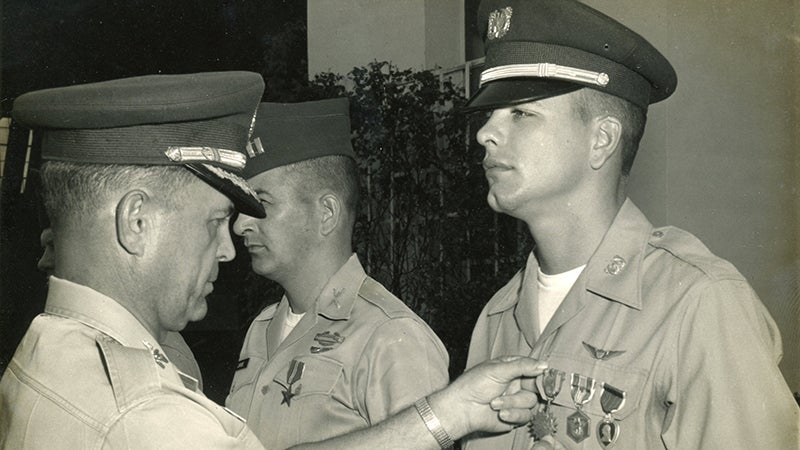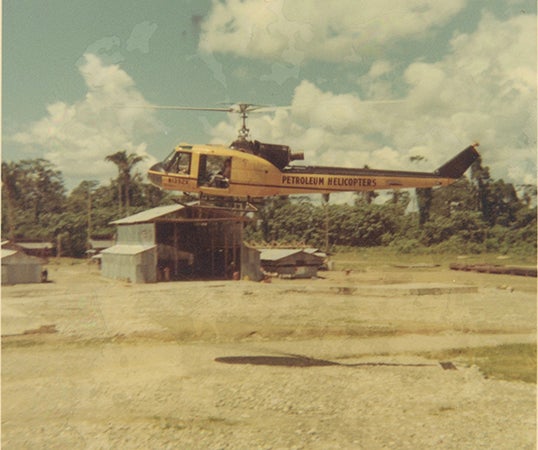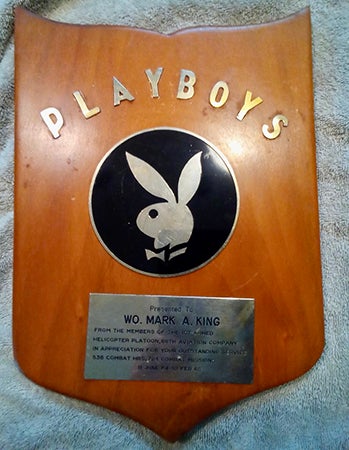Mark A. King, WO1, U.S. Army, Helicopter Pilot, Vietnam War Part 2
Published 1:00 pm Friday, February 3, 2023

- WO1 Mark A. King receives the Bronze Star Medal, the Air Medal with 15 Oak Leaf Clusters, and the Army Commendation Medal at Ft. Benning, Georgia, July 23, 1965. Making the presentation is Col.William H. Zimmerman, LAAC Commander. [Photo: Mark King]
|
Getting your Trinity Audio player ready...
|
By the time Warrant Officer Mark A. King was medically-evacuated from Vietnam on February 9, 1965, he had completed more than 725 combat missions with more than 538 hours in combat.
Continued from Part 1.
King’s Dragon Platoon was part of an assault near Benh Gia that had lost two armed helicopters and had about a dozen wounded men. King recalled the next mission after that, “A few days after the first Benh Gia mission, we flew back with a heavy fire-team. The U.S. Special Forces advisor had sent word that the VC were massing a large force near Benh Gia and he was concerned that his force might be overrun.
“It was getting late and my fire-team leader, Roy Azbel [Dragon 3-2], called for a low-level strike over the tops of the trees near a rubber plantation…About half-way through our firing run, Dragon 3-2 flew right into what looked like a curtain of tracers and broke left. I broke right to try and avoid the tracers. I could see that Dragon 3-2 was on fire about the same time he came on the radio screaming that ‘he was on fire.’ I told him I was right beside him and that he needed to try to make it to a clearing up ahead where I would pick him up.

King flew a helicopter like this Bell 204 for Petroleum Helicopters Inc. in Ecuador. [Photo: Mark King]
Not long after the battle of Benh Gia, the Dragon Platoon was stripped of its guns and made into troop transports [slicks]. King asked to be transferred to the Playboy Platoon which was still operating gunships. He was accepted and began operations with his new platoon immediately.
On February 8, 1965, the Playboy Platoon was part of an assault against a large VC force that had been detected north of Benh Gia. This time, the entire helicopter company of 20 gunships was sent in to support the assault. King recalled, “The VC were well dug in and camouflaged in the LZ [landing zone]. As the first wave of helicopters deployed their troops in the LZ, the VC opened up with withering fire. They shot down three of the troop-carrying aircraft and one of our gunships, killing the pilot, WO John Urban.” The fighting in the LZ was hand-to-hand and continued until dark when the VC retreated back into the jungle. The Playboy Platoon returned to their staging area near Vung Tau [about 60 miles southeast of Saigon, on the coast] to rearm and refuel.
On February 9, two gunships flown by WO King and Lt. DeYoung, were sent back to the assault area north of Benh Gia to provide escort for a maintenance helicopter and a downed Huey. WO King was flying Playboy 17 and the fire team leader, Lt. DeYoung, was flying Playboy 18.
King recalled, “After the other aircraft had departed the area, we left and as I was climbing to altitude, my ship came under fire by a large caliber weapon. We heard four large explosions followed by a fifth that struck our engine… I immediately looked for a place to land. I turned left toward a small clearing in the dense jungle. I saw that I was going to be short so I pulled my rotor down to 5000 rpm in order to stretch my glide… we were falling like a rock.
“Somehow the good Lord saw fit to place a large tree in my path. The tree came through my windshield and slowed our rate of descent and forward air speed. We made a hard landing and tipped over on our side in the 10-feet tall elephant grass…I was semi-conscious and still strapped in when Lt. DeYoung landed his gunship to bring us out…The rest of my crew got out without a scratch…I managed to walk to DeYoung’s ship despite being semi-conscious and in incredible pain.”

Plaque presented to WO1 Mark A. King from the 1st Armed Helicopter Platoon, 68th Aviation Company, commending King’s 538 combat hours and 723 combat missions. [Photo: Mark King]
After King’s arrival at the hospital he received a phone call from his dad. The Red Cross had notified a local office in Andalusia, Alabama, about Mark’s condition and location. The manager of the local Red Cross was Laurie Hamiter, who had arranged the phone call.
After a short stay in the Philippines, King was flown to Brook Army Medical Center at Fort Sam Houston in San Antonio, Texas. It had been five days since the crash. He recalled his stay there, “It wasn’t until my arrival there that I was fully conscious. They kept my legs packed in ice for two months to restore circulation. I had to lie flat on my back for two months in order for my injuries to heal. I was there for four months before I was released.”
After leaving San Antonio, King was assigned to Fort Rucker, Alabama, where he was enrolled at the instrument flight school. Upon completion of the school, he was certified as a flight instructor and trained helicopter pilots until his discharge in May 1967.
He had served four years and been awarded the Bronze Star, the Army Aviator Badge, the Sharp Shooter Badge [rifle], the Armed Forces Expeditionary Medal, the Air Medal with 16 Oak Leaf Clusters and “V” device for Valor, the National Defense Service Medal, Vietnam Jump Wings, the Vietnam Campaign Medal, the Purple Heart with one Oak Leaf Cluster and the Army Commendation Medal with “V” device for Valor.
After leaving the Army, King was hired by Page Aircraft of Lawton, Oklahoma. He ferried new helicopters from Fort Worth, Texas, to Stockton, California, where they were sent to Vietnam. After two months, Page lost their government contract and King went to work for Petroleum Helicopters, Inc. out of Lafayette, Louisiana. He flew workers to and from off-shore oil rigs for about six months before being sent to Ecuador to work for the same company.
In Ecuador, King flew oil drilling equipment to various jungle locations. He flew the Bell 204 helicopter which was the civilian version of the UH-1B Huey. King’s work in Ecuador lasted about ten months until the day his helicopter was caught in a treacherous downdraft and crashed. The aircraft rolled up against a berm beside a dirt road that prevented a steep roll off the mountainside. King and the other five men on the aircraft suffered multiple injuries.
He recalled, “My nose was smashed, my jaw was broken, my skull was cracked, I had severe facial injuries and my left foot was dislocated and broken. We had been operating in the jungle wearing only light clothing and we crashed at 12,000 feet up in the Andes mountains where it was about 28 degrees…After a while, two native Indian men came to us on horseback. They went to a nearby village where some Wycliffe missionaries were working on a radio tower [where they would broadcast to the natives in their own language]. They called Quito for help.
“Help finally came after about six hours and they carried us to a hospital in Quito which was operated by Wycliffe Bible Association. After about a week there, I was flown back to the States and taken to Jackson Hospital in Montgomery, Alabama.”
After about a week, King went to stay with his parents in Andalusia. He was still on crutches and his jaws were wired shut. He stayed with his parents until January 1969 when he decided to join his younger brother, Harry, at Livingston University. He earned his degree in Business Administration in 1972 and went to work in the shipping department of the Alatex in Andalusia.
After a couple of years, he went to work with Tractor and Equipment Company of Montgomery, Alabama. King still worked out of Andalusia and continued to work with them through 1977, when he began work with State Farm Insurance. He retired from State Farm after 24 years.
Mark A. King married Norma Worley in December 1970. They had three children, Marcie, Anthony and Walter. Mark and Norma divorced in December 1988.
Mark married Lynn Hutcheson Shipp in March 1997. She had two sons, Bryant and Dustin Shipp.
Mark and Lynn currently reside in Andalusia.
Mark A. King asked to add one closing remark, “It was an honor to serve in the UTT Helicopter Company, the world’s first armed helicopter company. The men I served with were closer than brothers, not by blood but with mutual respect and professionalism. Other pilots and units admired us and the VC feared us. I have no animosity toward the Vietnamese people – they were caught between communism and democracy and we lost. We did not lose on the battlefield, they just had a greater will to win.”
John Vick
The author would like to thank Mark and Lynn for helping to tell his heroic story. Mark said he did so in the hope that it will encourage others to do the same.




